
Beach coolers come in many different shapes and sizes. Photo: Steve Andrews//The Inertia
The right beach cooler will increase your time in the sand exponentially. Without one, you’re stuck with warm beverages that will only get warmer as the day goes on. At the end of the day, the best beach cooler is the one you own (and doesn’t leak). But if you want a major upgrade, you’ve come to the right place.
We’ve collected the best beach coolers for both personal use and for big days out with friends and family, ensuring that no matter the occasion, food and drinks will be cold and ready to go. The end result? Extra time at the beach chilling (pun intended) with your friends and cohorts to let those long days go well into the night. Don’t forget your sunscreen.
Navigate To: Comparison Table | How We Tested | Buyer’s Guide
Related: Best Coolers | Best Backpack Coolers | Best Soft Coolers | More Gear
Editor’s Note: We updated this guide in August 2025 with a couple of new coolers, refreshed links, and improved formatting. We also removed an out-of-stock option.
The Best Beach Coolers of 2025
Best Overall Beach Cooler: RTIC 52 QT Ultra-Light Wheeled Cooler
Best Backpack Cooler: YETI Hopper M20
Best Budget Beach Cooler: Maelstrom Backpack Cooler
Runner-Up Best Overall Beach Cooler: Yeti Roadie 48 Wheeled Cooler
Jump To More Of The Best Beach Coolers
Best Overall Beach Cooler
RTIC 52 QT Ultra-Light Wheeled Cooler ($249)
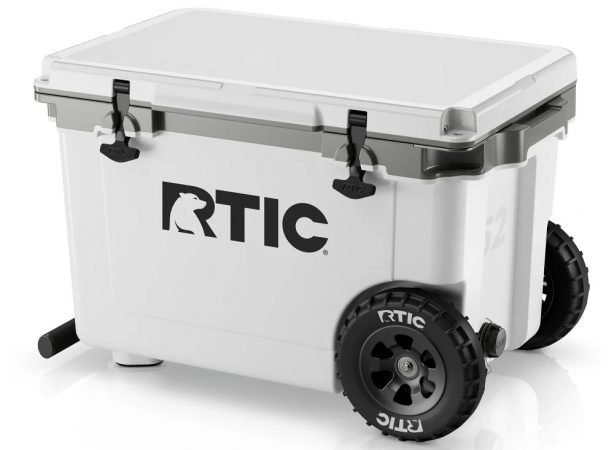
Insulation: Closed-cell foam
Capacity: 52 qt
Weight: 30 lbs
Pros: Premium quality with a great price point
Cons: Handles/Wheels make wasted space when packing
Coolers come in all shapes and sizes, so it’s hard to narrow down one cooler to rule them all. However, the RTIC 52 QT Ultra-Light Wheeled Cooler has enough of what we need (as well as a few bonuses) that helped us crown this our best beach cooler of 2025. It’s not too big that one person can’t move it, and thanks to the tough, easy-rolling wheels, one person can take it over anything from a rocky trail to dry sand. It’s also big enough to store enough beverages, ice, and food for a whole group, so you don’t have to leave the beach prematurely.
With a host of bonus features like a metal bottle opener, fold-away handles, and a basket on the lid to keep dry goods dry, the cooler is made for long days at the beach (and maybe some long nights as well). It clocks in at only 30 pounds (empty, of course). That weight isn’t too shabby considering we still had ice inside after 5 days of testing, even after opening and closing during that period. Last but not least, the price point comes in at far less than comparable coolers with similar durability and insulation. If you only own one cooler, the RTIC Ultra-Light Wheeled Cooler should be the one.
Check out our full review of the RTIC Ultra-Light cooler.
CHECK PRICE ON RTIC CHECK PRICE ON AMAZON

The RTIC 52 QT Ultra-Light Wheeled Cooler has just about everything you need for the beach. Photo: Steve Andrews//The Inertia
Best Backpack Cooler
YETI Hopper M20 ($325)
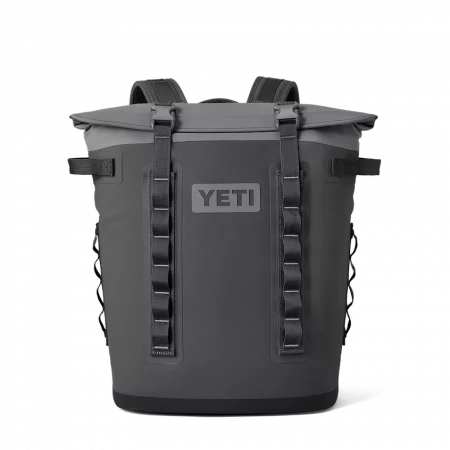
Insulation: Closed-cell foam
Capacity: 25 qt
Weight: 7.7 lbs
Pros: Magnets instead of zippers, durable
Cons: Pricey
It’s no secret that YETI coolers don’t come cheap. But it’s also well known that YETI makes some of the best coolers in the game. The M20 Soft Backpack Cooler is no exception.
One of the downsides of most soft coolers is the challenge of the zipper. YETI sought to remove this problem by creating a magnetized seal, along with a couple of buckles for added security. If you had a prior version of one of YETI’s backpack coolers, then you know that the magnet was kind of terrifying. YETI has toned it down a bit with the M20, offering a reliable seal without the risk of your fingers getting pinched. Add in a couple buckle straps to seal the deal, and the cold air ain’t going anywhere until you open it up.
The M20 is comfortable to carry and has lots of attachment points for securing gear, so you can stay hands free if you wish. The M20 will keep your drinks cold for days – if you prefer something reusable instead of ice the YETI Thin Ice is an awesome option. While the price is a bit steep, YETI makes coolers you can rely on and the M20 is a great backpack option.
Check out our full review of the Yeti Hopper M20. For more backpack coolers, check out our guide to The Best Backpack Coolers.
CHECK PRICE ON REI Check Price on Yeti

The Yeti Hopper M20 is rugged, comfortable to carry, and keeps items cold for hours if not days. Photo: Haro//The Inertia
Best Budget Beach Cooler
Maelstrom Backpack Cooler ($40)
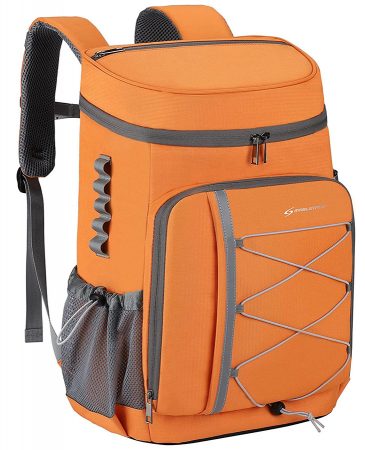
Insulation: Polyester
Capacity: 35 cans (32 L) + front pocket for cutlery + dishes
Weight: .95 lbs
Pros: Leakproof, large capacity for a backpack
Cons: Ice doesn’t last longer than an afternoon, materials aren’t ultra-durable
There are a bunch of different coolers in the lower budget range, but we found the Maelstrom Backpack Cooler to have a solid combination of features that you need to have a good day on the beach. It keeps drinks cold (as it should) for a solid afternoon, and claims 7 hours without ice. Keep in mind that’s if you don’t open it! But add a bit of ice and this backpack cooler served us for a full afternoon at the beach.
The extra pockets are well thought out — the front pocket has space for dishes and cutlery for a perfect beach date. While nothing on this cooler stood out as premium, the overall build quality is solid, and for less than $40 at the time of publishing, we can highly recommend this as a budget beach cooler. The Maelstrom is sturdy, functional, and will last you a while if treated properly. It’s not premium by any stretch of the imagination, but the money saved will mean extra contents for whatever you need.
CHECK PRICE ON AMAZONRunner-Up: Best Overall Beach Cooler
Yeti Roadie 48 ($425)
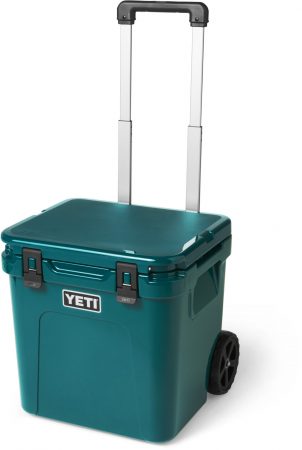
Insulation: Rotomolded plastic
Capacity: 48 qt
Weight: 28.3 lbs
Pros: Easy for one person to move on their own
Cons: Telescoping handle can get sand stuck inside and jam up
Yeti’s latest release is a bit of a game-changer when it comes to large coolers. Over the years, the brand’s legion of fans gave feedback on what was missing in their line and what was important for a large-capacity cooler. The result is the Roadie 48 – a higher-profile wheeled cooler that uses the laws of physics to make life easier.
Leverage can do wonders, and having a cooler that is roughly a cube shape is more balanced and easier to move around. Where other coolers require you to lift one end to move them, with this rig, you simply tilt, and the wheels carry the brunt of the weight. Add in the extra-long telescoping handle, and it’s surprisingly easy to wheel around this cooler even fully loaded. Having some height also allows for wine bottles to sit upright, and with additional dividers available, you can keep beverages and food separate with ease.
This finished just behind the RTIC Ultra-Light for Best All-Around due to two important points. One was that the telescoping handle would occasionally fill with sand, so if the beach is the primary destination for your cooler, you might want something where the handle folds out, such as the RTIC or Pelican Elite. The other point was that the drain plug does not remain attached, so it’s prone to getting lost. This is true for all YETI coolers, and the Pelican Elite and RTIC Ultra-Light definitely get a nod because the drain plug has a metal leash to keep it attached at all times. Otherwise, the Roadie is the perfect large-scale mobile beach cooler.
We found the 48 qt to be in the sweet spot for size vs portability, but if you need something a bit bigger, fear not, as it also comes in a 60 quart version. We also just tested the newer 32-quart Roadie. While we also loved that version, the 48 still offers the best combination of weight, size, and capacity in our testing.
CHECK PRICE ON REI CHECK PRICE ON Yeti

The upright and balanced design paired with durable wheels makes the Yeti Roadie 48 super easy to roll. Photo: Nathan Lemin//The Inertia
More of the Best Beach Coolers
The above represents our top 4 picks for most beach-goers. Basically, those are what we recommend to friends and family asking for a great cooler. However, the below options are still great, and in many cases the best for specific use cases. Don’t miss the best of the rest beach coolers, and why one of these might make the best pick for you.
Best Beverage Cooler
BruMate BruTank 35-Quart Rolling Cooler ($300)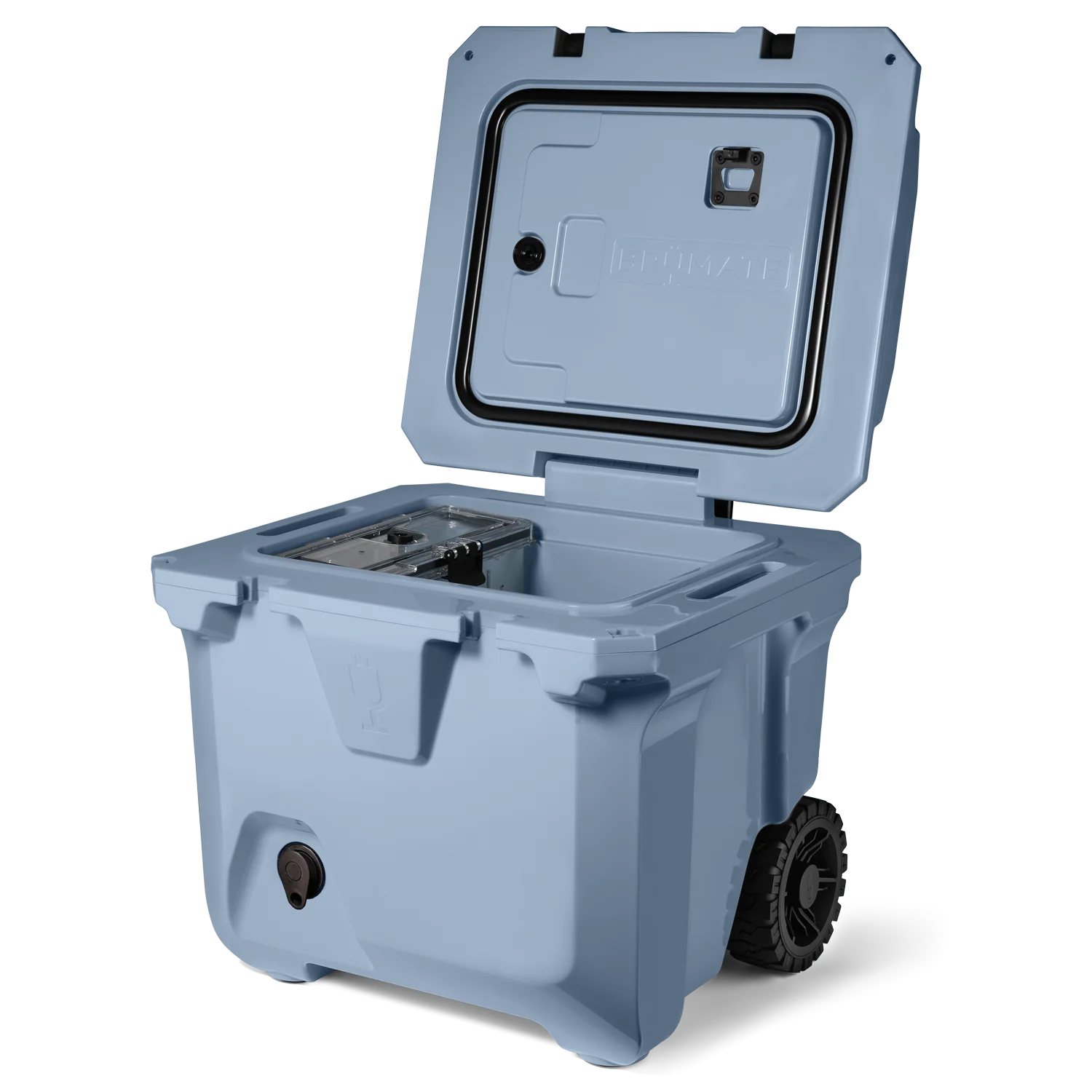
Insulation: Rotomolded
Capacity: 35 qts
Weight: 31 lbs
Pros: Internal 1.8-gallon drink tank is great for mixed drinks, sturdy design, mobile for beach
Cons: Tap sits low on cooler body, so elevating helps pour drinks
Brumate is a brand dedicated to keeping the cold drinks flowing. Launched in early 2016 with the Hopsulator can cooler, the brand doubled down that November with the Winesulator, a sleek insulated wine bottle that helped propel the brand into the spotlight. Since then, they’ve added a full line of well-designed and innovative products, all designed to keep your bevies ice cold. The BruTank is one of their more recent additions, adding a little flair to the classic hard cooler design by way of an internal 1.8-gallon drink tank with a built-in tap.
We tested the 35-quart version, which also sports heavy-duty wheels and a telescoping handle for easy transportation across all kinds of terrain (including sand). The highlight feature, the embedded drink tank, is removable for easy cleaning. It’s also leak-proof, so your tasty drink doesn’t make a mess, even if the cooler gets tipped onto its side. Our one complaint with the design is that the spout for dispensing your concoction is quite low on the body of the cooler, so if you’re using this feature, it might be worth elevating the cooler on a bench or table for ease of use. Overall, the cooler is a sturdy, rotomolded design, boasting up to seven days of ice retention. The lid is leak-proof as well, and there’s a built-in bottle opener on the underside of the lid. Clean lines, fun colors, and subtle branding round out the package.
Check Price on BruMateExcellent Value Hard Cooler
Igloo EcoCool Roller 60 Cooler ($100)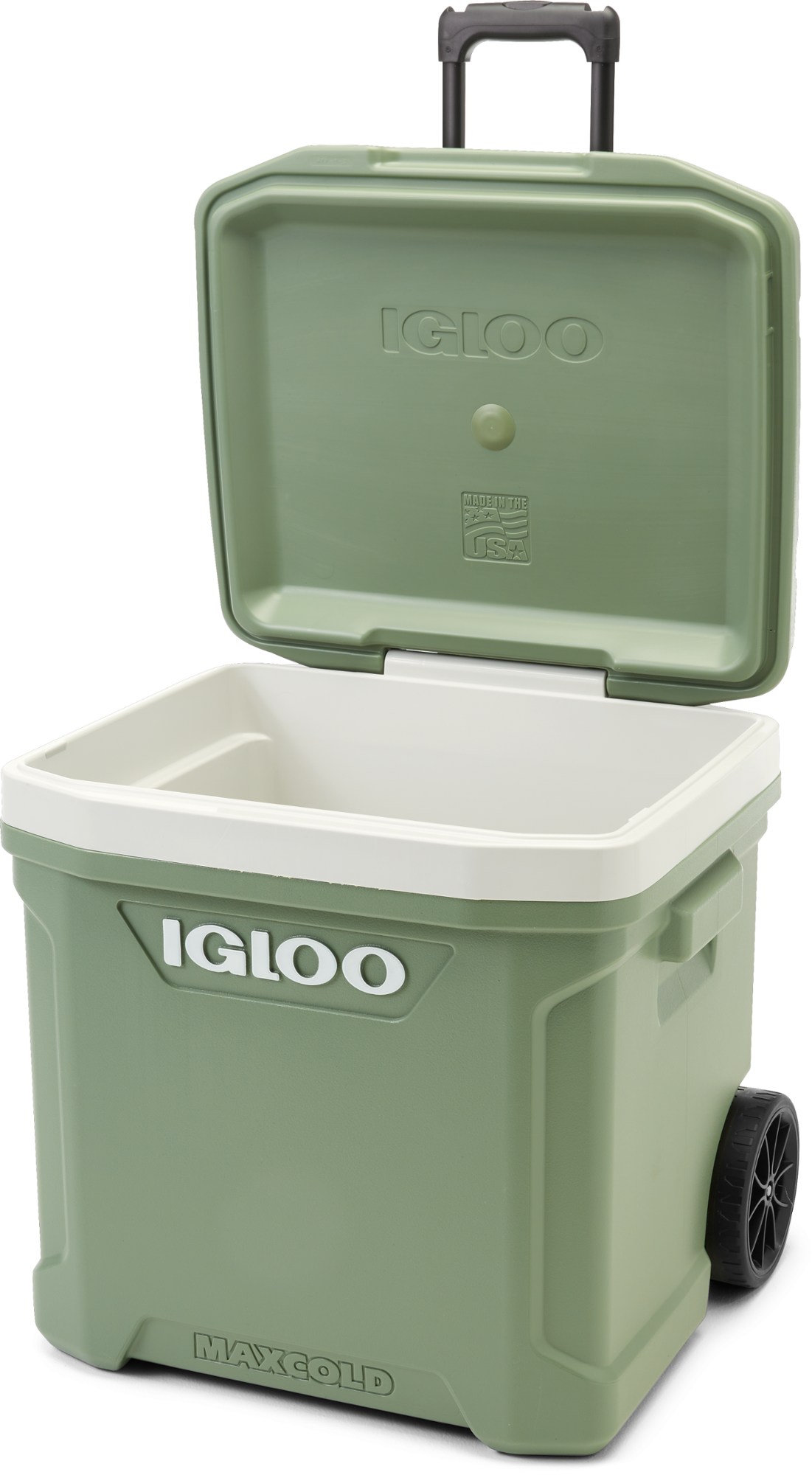
Insulation: ThermeCool
Capacity: 60 qts
Weight: 14 lbs
Pros: Inexpensive, transportable, pretty light
Cons: So-so ice retention, less durable than rotomolding
Bringing a cooler to the beach is always a great idea, but many of the options on this list are pricey, long-term investments. But spending hundreds of dollars isn’t a necessity to get a great cooler perfectly capable for a great day on the water. We’ve been testing the Igloo EcoCool Roller 60 Cooler, and love it for its affordable price point and great all-around performance.
The Igloo EcoCool Roller is a wheeled option with a similar telescoping handle and cube shape to the Yeti Roadie or the BruMate BruTank. It has been sturdy, but maybe a touch less durable feeling than those rotomolded options. We love that this cooler is made from post-consumer recycled plastics, and the ThermeCool insulation reduces C02 and VOC emissions. Other useful features, like cup holders on the lid, make this the ideal budget hard cooler for the beach.
Read our full review of the Igloo EcoCool Roller 60.
Check Price on REI Check Price on Amazon
Longest Ice Retention
RTIC 110 QT Hard Cooler ($365)
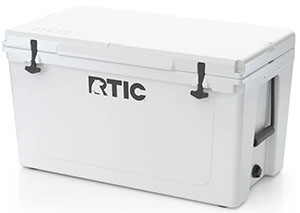 Insulation: 3 inch foam
Insulation: 3 inch foam
Capacity: 110 qt
Weight: 48 lbs
Pros: Long lasting ice retention, lower price than comparable models
Cons: Super heavy when fully loaded
RTIC boasts longer ice retention than its competitors, and we had to test that out for ourselves. They’re right. Science says that the larger the insulator, the better it performs, so it’s no surprise that their 110 qt cooler would hold ice for a long time. If you follow the proper guidelines, this cooler can keep things chilled for almost a week.
With three-inch insulated walls, your ice will stay frozen for days, literally. Like the Yeti, it has rotomolded construction which is super tough. The cooler features heavy-duty T-latches and a freezer grade gasket, as well as no-fail hinges, no-sweat exterior, cool lift design, molded side handles, and tie-downs so your cooler is always where it needs to be. Bonus points for this cooler to double as a bench or step stool for camping and places where furnishings are a minimum. Be mindful, if you’re bringing this beast to the beach, you’ll likely want a wagon or strong buddy to help transport it.
RTIC also has smaller models in 65 qt and 45 qt if the 110 is too much to carry. But if long-lasting ice retention is your requirement, the 110 is a great value for larger groups or extended trips.
CHECK PRICE ON RTIC CHECK PRICE ON AMAZON
Excellent Value
ENGEL 60QT Ultralite ($240)
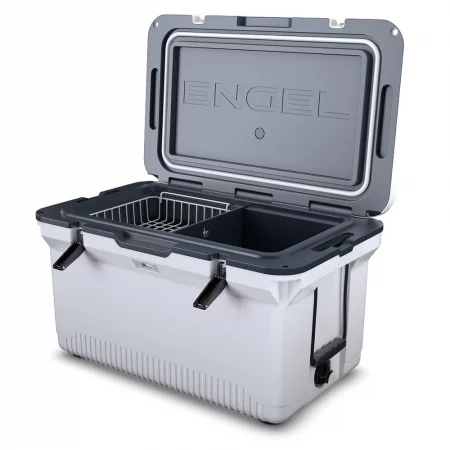
Insulation: Closed-cell foam
Capacity: 60 qt
Weight: 21.5 lbs
Pros: Super light for the size
Cons: Handles are prone to wear
Engel has made a name for itself in the hunting and fishing scene for durable, dependable coolers, and even powered coolers for those extended trips. What we really liked about their new Ultralite cooler is in its name: it’s far lighter than other coolers in its size category, without sacrificing ice retention. Sure, it may not have as long-lasting an effect as some burlier models, but for a day at the beach, it performed perfectly. And let’s not overlook the price: At $200, it’s much more affordable than some of the other premium brand-name models on this list. It also comes with a few included extras, such as a wire basket for dry goods and a divider to separate drinks and food.
The only downside is that the rope handles aren’t as durable as some others, so if you abuse the cooler, you might want something a bit more rugged. But with a far lighter weight than other larger coolers, the tradeoff might be worth it. Plus, it’s easy enough to change those out.
CHECK PRICE ON Engel CHECK PRICE ON AMAZON
YETI Tundra Haul Wheeled Cooler ($425)
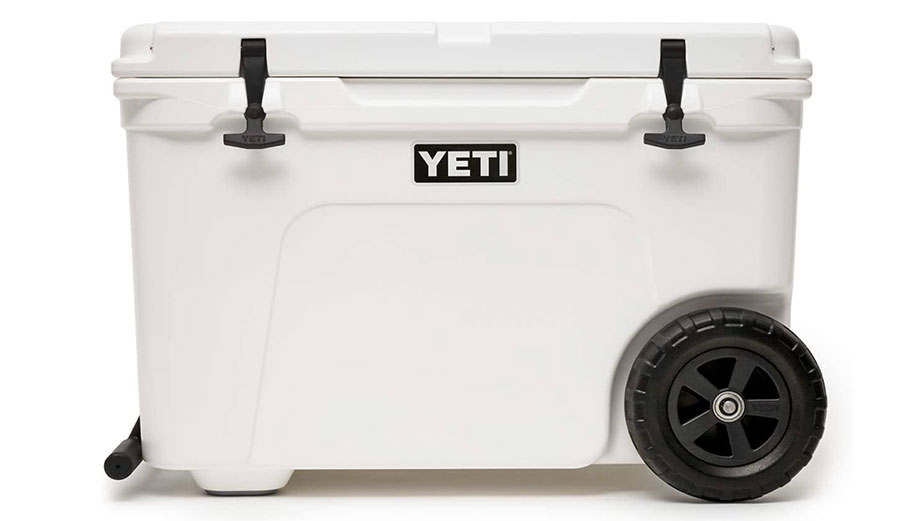
Insulation: Rotomolded Plastic
Capacity: 82 cans (without ice)
Weight: 37.5 lbs
Pros: Legendary reputation, easy to maneuver
Cons: You’re paying a premium for the brand name
Yeti, as you’re probably aware, is the gold standard for coolers. Standard Yeti coolers, due to their rugged rotomolded design, have been a bit of a hassle to lug around. The Tundra Haul is Yeti’s first cooler on wheels, which you will appreciate after walking 25 minutes through the sand and burning sun because your friend decided he’d post up at the other end of the beach.
While the wheels and towing handle are great, the one downside is a lack of a handle on the other side in case you need to pick it up, which costs it a point in the “portability” category. The Haul has rotomolded construction, which makes the thing almost bomb-proof, and the wheels are solid, single-piece tire construction that is impact and puncture-resistant, so you know you’re getting to where you want to go, and that things will be cold when you get there.
We now prefer the Roadie above, because Yeti has improved on the portability design with a more balanced load and telescoping handle. While the Haul is still a great option, the Roadie is slightly more versatile.
CHECK PRICE ON REI CHECK PRICE ON YETI
ICEMULE Boss ($380)
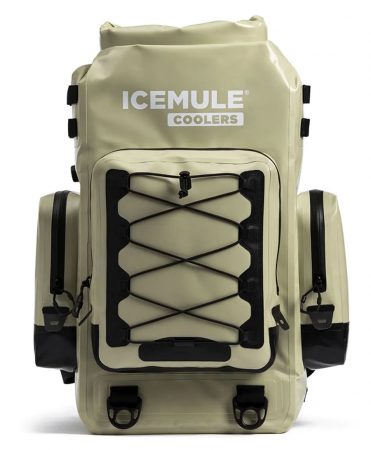
Insulation: Foam
Capacity: 24 cans (with ice) + extra pockets = 30L
Weight: 6.6 lbs
Pros: Ergonomic, durable, great ice retention
Cons: Pricey, size-to-capacity ratio isn’t great
Even if you ignore the fact that the ICEMULE Boss is a fully waterproof cooler with unbelievable ice retention, it’s just an awesome backpack that can carry a ton of stuff. The shoulder straps and back padding help ease the burden of a heavy load, so feel free to fill it to the brim with up to 24 cans (with ice) in the main compartment. You’re really only limited by back and shoulder strength for how much more you’d want to add to the backpack cooler. Two side compartments and a larger one on the back (all waterproof as well) give additional room for supplies such as a first aid kit, dry food storage, sunscreen, etc.
Even that would be enough to call it a day and make this one of our favorite backpack coolers. But add in the external storage options, such as webbing for a rain jacket, clip loops on the bottom, and 16 loops on the side for clipping on whatever you can think of, and you’ve got a carrying solution for much more than just cold drinks. This thing is a beast and blows the competition out of the water. That said, it might be overkill for shorter adventures at the beach.
CHECK PRICE ON ICEMULE CHECK PRICE ON AMAZONICEMULE Jaunt 15L ($120)
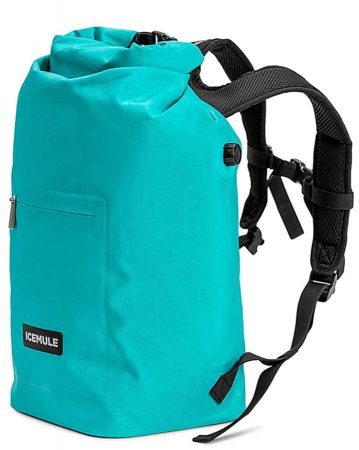
Insulation: Muleskin (proprietary to Icemule) + air
Capacity: 15 cans (with ice)
Weight: 2 lbs
Pros: Packs up for easy storage, waterproof, floats
Cons: Ice retention not great after 24 hours
This cooler could also win the “Most Unpretentious” if we were to make such a category. But to believe that this stylish and comfortable waterproof backpack can also keep drinks cold? And also float should the need arise? That’s an enthusiastic yes!
ICEMULE has set itself in a category of its own by creating some exceptionally high-performing cooler bags that are well-built, waterproof, and keep their cool for a long time. You can easily fit a 12-pack with ice in their 15L version of the Jaunt series, and even 4 wine bottles for those so inclined. With premium lining and an inflatable air pocket to add further insulation, this cooler rivals many hard coolers for ice retention.
Add in the fact that you can carry it on your back and roll it up and stash it when not in use, and you’ve got yourself an ultra-portable, unassuming cooler to take to the beach, on a boat, or on big hikes without ever worrying about leaking. It’s great for surf trips where space is an issue — just roll this up and stash it in your board bag, and you’re ready to go when you reach your destination. Plus, there’s a bonus pocket in front to keep your keys, wallet, and phone safe and dry.
They also have a smaller 9L version if you are looking for something even more portable, or a 20L version that uses recycled materials. However, we found the 15L to be right in the sweet spot for capacity and size.
CHECK PRICE ON ICEMULEPelican Elite 65 Wheeled Cooler ($520)
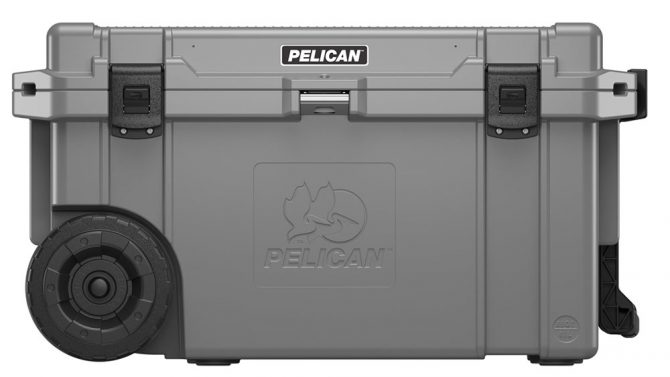 Insulation: Injection-molded polyurethane
Insulation: Injection-molded polyurethane
Capacity: 65 qt (64 cans + ice)
Weight: 53 lbs
Pros: Wildlife-proof closure, virtually indestructible
Cons: Pricey, heavy even with wheels due to its length
Pelican products go far beyond just coolers. The company started out as providing cases for scuba diving equipment in the 70s, and has steadily built a reputation for housing everything from camera gear to providing reliable storage for military and law enforcement. With well over 40 years of innovation in a variety of fields, they recently dove into the cooler market. We found Pelican Coolers to be some of the toughest options out there.
We tested the Elite 65 Wheeled Cooler and found that it lived up to the reputation, and then some. With 2″ polyethylene insulation, this cooler will keep whatever is inside cold for days. So whether you’re bringing food and drink to a big beach party or heading on a deep-sea fishing mission, this is an excellent option. Featuring some of the most rugged wheels on the list, we found that despite the size, the Pelican Elite rolled well through a variety of terrain. Sure, the price tag might be a tough pill to swallow, but rest assured that this cooler will last for years on the beach or a boat, in the desert, or wherever else you may go.
CHECK PRICE ON PELICAN CHECK PRICE ON AMAZON
ORCA 26 qt Hard Cooler ($275)
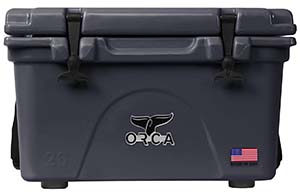
Insulation: Rotomolded plastic
Capacity: 26 qt
Weight: 25 lbs
Pros: Extremely durable, bonus cargo net for keys, phone, etc
Cons: Can’t quite fit a 24-pack
While not as well-known as many other hard coolers, ORCA is a standout that hopefully will gain more steam as people discover it. Their coolers are made in the USA with quality rotomolded construction and have a few extra features that other small hard coolers are missing. One is the rubber feet that keep it in place on whatever surface. Another is a cargo net on the back where you can easily stash necessities like your keys, wallet, phone and other small items.
We found the Orca 26 to reliably keep ice and beverages cold. Sometimes, smaller coolers struggle to keep things cold due to less insulation, but the Orca cooler strikes an ideal balance between size and insulation. Their coolers also come in a huge variety of colors that will suit any personality, or for those super-organized, you can color-code multiple coolers for easy access in a rush. We loved the 26 qt for its portability to and from the beach, but these coolers come in a variety of sizes from 20 qt all the way up to 140 qt, ensuring that, whatever your needs, ORCA has you covered.
CHECK PRICE ON AMAZONBOTE Kula ($299)
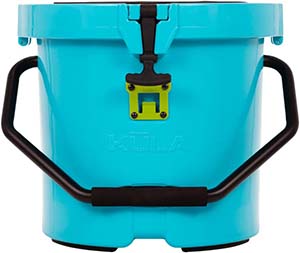
Insulation: Rotomolded plastic
Capacity: 20 qt
Weight: 13 lbs
Pros: Unique design, bonus bottle opener and magnetic lid
Cons: Circular shape isn’t the most space-efficient
Winning points for most unique beach cooler design (even though it’s actually a design that most people are familiar with), the Kula by BOTE takes the 5-gallon bucket to a whole new level. This bucket, though, is not like the others. It keeps drinks cold and can double as a seat.
BOTE is known for its ultra-durable, inflatable SUPs and kayaks. Venturing into the cooler market may seem like an oddity; however, when you think about it, both of these activities become exponentially better with some cold beverages on hand. Thanks to BOTE’s proprietary Magnepod on the top, you can rest their custom drinkware, Bluetooth speakers, and anything else magnetic on top with a smaller chance of it toppling over. Add in a bottle opener and a sturdy handle, and you can tell the BOTE folks are serious about drinking on the water, or anywhere else, really.
Whether or not you use their watercraft is irrelevant to the fact that this cooler is a great drink companion. Due to its shape, it’s not as efficient for food or square-shaped containers, but if your main focus is cold drinks, this is a fun and unique option. It’s easy to carry to and from the beach and makes a great seat in a pinch. Plus, it works well on any boat.
The Kula comes in a variety of sizes and colors to suit whatever your situation or style may be.
CHECK PRICE ON BOTE CHECK PRICE ON AMAZON
BruMate MagPack 24 Soft Cooler ($200)
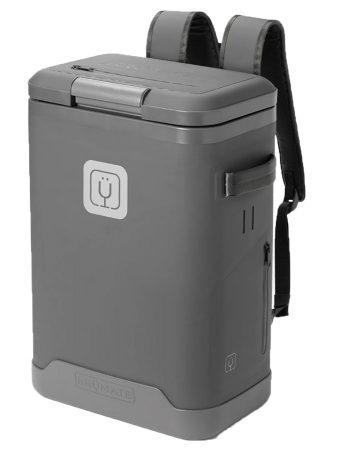
Insulation: Closed-cell foam
Capacity: 24 cans
Weight: 7.74 lbs
Pros: Easy to carry, waterproof, more durable than other backpack coolers
Cons: Pricey for the size
Backpack coolers are perfect for on-the-go adventures, but many lack the sturdiness of a traditional hard cooler. The Brumate MagPack cooler addresses this by offering a leak-proof and waterproof design, paired with closed-cell foam insulation to keep your drinks cold. It’s a portable, durable solution that’s easy to carry—just what you need for a spontaneous beach mission. It also has 3 small zip pockets for stashing essentials such as your phone, wallet, and keys, so you can cruise to the beach with your board shorts without needing much else.
Best for small groups, this cooler can hold up to 24 cans with ice, making it ideal for trips off the beaten path without feeling like a huge burden. However, its elongated shape can make it tricky to find what you’re looking for quickly, leading to more time with the lid open, which could affect the temperature inside. If you’re packing a variety of food and drinks, this cooler might not be the best fit. But if you’re simply looking to bring a stack of beverages and don’t want to lug a larger cooler around, the MagPack could be the perfect solution.
Check Price on BruMateThe Pouch by Kanga Coolers ($70)
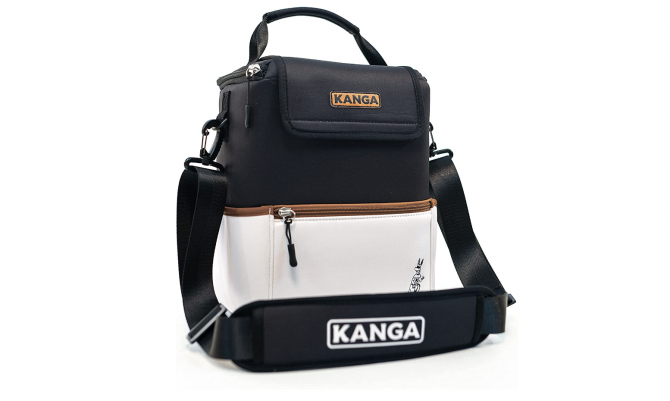
Insulation: Neoprene
Capacity: 12 cans
Weight: 1 lb
Pros: Easy to move around, can slip a 12-pack straight into it
Cons: Won’t stay cold longer than an afternoon
Another favorite here at The Inertia is Kanga’s line of iceless cooler bags. Aside from doing a great job keeping things cold, they make a nice-looking accessory if that type of thing is important to you. If you only need your drinks to stay cool for a few hours and don’t want to deal with ice, this is the option for you. The Pouch is capable of keeping a six-pack of bottles, or a 12-pack of cans, cool for up to seven hours, an impressive feat without ice.
If you want your drinks to stay cold for longer, you can always add ice, of course. And if you want to carry around more than a 12-pack of cans, check out the Kase Mate, which can hold up to 30 cans. To top it all off, the coolers come in a variety of stylish colors, and a tree is planted for every purchase to help offset carbon emissions.
CHECK PRICE ON AMAZONBeach Coolers Comparison Table
| Model | Price | Capacity | Empty Weight | Features |
| RTIC 52 QT Ultra-Light Wheeled | $249 | 52 qts | 30 lbs | Sturdy handle, bottle opener, tough wheels |
| YETI Hopper M20 | $325 | 25 qts | 7.7 lbs | Magnetic closure, gear loops |
| Maelstrom Backpack Cooler | $40 | 34 qts | .95 lb | Front pocket for dishes/cutlery, gear loops |
| YETI Roadie 48 | $425 | 48 qts | 28.3 lbs | Cube shape, long extending handle |
| BruMate BruTank 35 Quart Rolling | $300 | 35 qts | 31 lbs | Internal 1.8 gallon drink tank, wheeled |
| Igloo EcoCool Roller 60 Cooler | $100 | 60 qts | 14 lbs | Inexpensive, transportable |
| RTIC 110 Ultra-Tough Cooler | $400 | 110 qts | 48 lbs | 3″ thick walls for long-lasting ice retention |
| Engel 60QT Ultralite | $240 | 60 qts | 21.5 lbs | Comes with wire basket and divider |
| YETI Tundra Haul | $425 | 62 qts | 37.5 lbs | Rotomolded construction |
| ICEMULE Boss | $380 | 31.7 qts | 6.6 lbs | Waterproof, air insulation, 3 extra pockets, gear loops |
| ICEMULE Jaunt | $120 | 15.8 qts | 2 lbs | Waterproof, air insulation |
| Pelican Elite 65 Wheeled | $520 | 65 qts | 53 lbs | Tough construction, built to last |
| ORCA 26 | $300 | 26 qts | 25 lbs | Cargo netting for small extras |
| BOTE Kula | $299 | 20 qts | 13 lbs | Magnetic top, bottle opener |
| Brumate MagPack | $200 | 24 cans | 7.74 lb | Backpack cooler with a hard-shell casing and zip pockets for extras |
| The Pouch by Kanga Coolers | $70 | 10 qts | 1 lb | Can fit a whole 12-pack without taking out of the box |

24 hours into our ice test, and most coolers are still holding strong. Photo: Steve Andrews//The Inertia
How We Tested Beach Coolers
Steve Andrews took the lead on beach cooler testing and affiliate editor Nathan Lemin lent support. There are a ton of options for coolers out there out there, and there only seems to be more every year. People expect cold beverages not only at the beach, but also when camping, tailgating, or on the lawn at the state fair catching the Doobie Brothers with the folks. So we did our best to rate the coolers on a few standards that we thought you’d find important when looking for a good beach cooler.
Features are awesome, but they don’t mean much if you can’t move the cooler around, so portability is a big consideration. We also compared the size of the cooler to the capacity inside, simply by factoring each cooler’s volume on the inside vs. the outside. Ice retention is also an obvious factor, but instead of taking the companies’ word for it, we went out and actually filled the things with ice and drinks to see how long they could keep their chill.

BOTE’s Kula works as a cooler, a bait bucket, and even an extra seat for fun waterborne trips, whether or not you have a BOTE inflatable to go with it. Photo: Lindsay Gough//The Inertia
Testing Ice Retention
The simplest way we figured to test the coolers was to fill it with ice. This of course isn’t a totally apples to apples comparison to a cooler full of food or drinks, but it was the best we could do to make it as variable-free of a study as possible. Then, we simply left the coolers to sit there and simmer in the summer heat. Since most coolers recommend shading, we covered them with a towel so as not to have direct sunlight be a factor. However, we didn’t heed the advice that manufacturers make to “pre-cool” the coolers before adding anything because let’s be honest — most of us rarely do that in real life.
Other factors besides ice retention involved lugging it to and from the beach, and seeing just how easy or hard the whole process is. Are the handles going to slip out of sweaty hands? Is the shoulder strap going to leave a mark? Does sand affect the wheels’ ability to roll? All these questions helped us decide the good from the not-so-good, to help you choose the best beach cooler for your needs.
We first published this review in November of 2023. We updated it in May 2024 and again in December 2024 with some new beach coolers, one of which became our new best overall (the RTIC 52 QT Ultra-Light Wheeled Cooler).

A small, soft cooler makes an excellent drinks cooler for the beach. Photo: Steve Andrews//The Inertia
Beach Coolers Buyer’s Guide
The best beach coolers come in various sizes, shapes, and designs — invariably, what’s best for you depends on your use. Choosing the right one can make or break your beach day. Here are some of the key factors to consider when purchasing a beach cooler.
Capacity and Size
The capacity of the cooler will determine how much food and drink you can carry with you to the beach. If you’re planning a day trip with family or friends, a larger cooler like the RTIC 110 Ultra-Tough Cooler or Pelican Elite 65 Wheeled will be necessary. However, if you’re going alone, a smaller cooler such as the ICEMULE Jaunt will suffice. Consider how much space you have in your vehicle for the cooler and how far you’ll have to carry it from the car to the beach.

Size, capacity, and cooler type all play a role in how easy it is to transport a cooler to the beach or camp. Photo: Nathan Lemin//The Inertia
Insulation
The insulation is what keeps your drinks and snacks cold. Look for coolers with thick, rotomolded walls and lids such as the YETI Roadie 48 to ensure maximum insulation. Some coolers also have additional insulation layers to keep the cold in and the heat out, such as air pockets in the ICEMULE Boss.
Portability
Beach coolers can be heavy and difficult to move around. Look for coolers with wheels or handles for easy transportation, like the RTIC 52 QT Ultra-Light Wheeled. A cooler with a shoulder strap or backpack-style straps (like the ICEMULE Boss) can also make it easier to carry through soft sand.
Durability
Beach coolers are often exposed to the sun, sand, and water. Look for coolers made of durable materials that can withstand the elements. The standard has been set with rotomolded plastic (such as the YETI Roadie 48 or RTIC 110 Ultra-Tough Cooler). Many coolers these days are also designed with rust-resistant hardware, which can help prolong their lifespan.

Rotomolded coolers boast impressive ice retention and durability. Photo: Nathan Lemin//The Inertia
Ice Retention
The longer your cooler can keep ice frozen, the longer your drinks and snacks will stay cold, simple as that. Look for coolers with thick walls and lids, as well as a tight seal to keep the cold in. The Pelican Elite 65 Wheeled was one of the best in test for retention.
Additional Features
Some coolers come with additional features like built-in bottle openers (RTIC 52 QT Ultra-Light Wheeled), cup holders (optional on the YETI Roadie 48), or even power (Anker EverFrost). While these features can be convenient, they may also add to the price of the cooler. Consider which features are most important to you before making a purchase.
Price
As you have seen here, beach coolers can come in a wide range of prices, from the price of a couple of movie tickets (our best budget pick, the Maelstrom Backpack Cooler, is about $40) to the price of a plane ticket (or more!). Consider your budget and how often you plan to use the cooler before making a purchase.
Brand Reputation
Look for coolers from reputable brands with positive customer reviews. These brands are more likely to produce high-quality, durable coolers that will last for multiple beach trips. YETI and RTIC have made names for themselves with coolers built to last. Pelican also has a reputation that goes far beyond cooler to industries that use their gear in life-or-death situations.
Warranty
Some beach coolers come with a warranty, which can give you peace of mind if something goes wrong. We recommend beach coolers with at least a limited warranty that covers manufacturing defects and other issues. Pelican offers a limited lifetime warranty on its coolers, which is pretty hard to beat.

Sometimes, you don’t need much. For those instances, we found the Icemule Jaunt to be a great option. Photo: Steve Andrews//The Inertia
Caring For Your Beach Cooler
A good beach cooler is a worthwhile investment in freshness and reliable frosty beverages after a surf session or a long day in the sand. Making sure you take care of it will help prolong that investment for years to come. Here are a few tips to ensure your beach cooler has a long, happy life:
Clean after each use
After each use, clean your cooler thoroughly with soap and water. This will prevent any bacteria or mold from growing inside the cooler. If your cooler has any stubborn stains, you can use a mixture of baking soda and water to clean it. Be sure to avoid harsh chemicals which can shorten the lifespan of the cooler — plus you don’t want those by your food and drink.
Dry completely
Before storing your cooler, make sure it is completely dry. This will prevent any mold or mildew from growing inside the cooler. You can use a towel or air dry the cooler in a shaded area.
Store properly
When storing your cooler, keep it in a cool, dry place. This will prevent any damage to the insulation or other components of the cooler. Avoid storing the cooler in direct sunlight or in a damp area where mildew and mold might make it a party zone.
Don’t overload your cooler
Avoid overloading your cooler with too much weight, as this can damage the insulation or other components of the cooler. Follow the manufacturer’s guidelines for weight capacity. Your back will also thank you.

Fitting 24 cans with ice, the BruMate MagPack is a spacious and durable backpack cooler, ideal for the beach. Photo: Nathan Lemin//The Inertia
What Type of Ice Should I Use in my Cooler?
There are three main types of ice: Cubed, Block, and Artificial. Some folks use dry ice in coolers, but we don’t think the risk of burns is worth the additional cold time.
Cubed Ice
This option is by far the most commonly used. It’s usually found at any corner store for a few bucks and will last an outing. It can also chill the contents of your cooler quite fast but inevitably will result in a pool of water. So anything other than drinks will end up a soggy mess if left unattended for too long.
Block Ice
Block ice will stay frozen the longest. I like to use this on long camping trips when you need things to stay cold for multiple days. If you wrap the block in a garbage bag, it’ll last even longer and keep from flooding the rest of the cooler.
Artificial Ice
This is the best option if you’re regularly using the cooler, but for larger coolers the price can add up. Still, the fact that it’s reusable is a nice bonus and after a few times out there it’ll pay for itself. The catch is you’ll need extra freezer space to chill it out, and it can take a while to cool things that are at room temperature similar to cubes or blocks. The major brands all sell their own versions, but our favorites were from Yeti or Pelican. If you just want something cheap and easy, most fishing shops will sell gel packs that work pretty darn well and will last long enough if you treat them nicely. But when they break, it’s not the best thing to find inside a half-melted cooler.
Our Recommendation
Our go-to method for chilling our cooler is using a combo of cubed ice and either block or artificial ice. The block/artificial ice will last longer, and the cubes will fill in the gaps to make for better insulation/cold distribution.
When the ice starts to melt, Don’t drain the water. It’s a common mistake but that ice-cold water actually helps keep the temperature down. The enemy of internal cooler chill is air, so the more volume you fill inside the cooler with ice/drinks/food, the longer it’ll stay cold.

A backpack cooler like the Icemule Boss works great at the beach. Photo: Rebecca Parsons//The Inertia
How to Get the Best Ice Retention
There are a few steps you can take before heading to the beach to ensure that your cooler performs the best. If long ice retention is of utmost importance, here are a few tips:
Pre-cool the items
Before placing your food or drinks in the cooler, it’s a great step to get them cold beforehand. We even like to freeze certain things (like a couple of water bottles) to help. This will ensure that the ice isn’t working too hard (and melting) to bring the temperature down.
Add food/drinks before ice
Having your items at the bottom and ice on top will ensure that the ice acts as an extra barrier of insulation. Be mindful that some coolers have a basket to help keep things dry, which we advise using for food if available. Having the ice on top does make it harder to find things in the cooler, though.
Fill the cooler up completely
Air is the enemy of cold. You want as little of it in the cooler as possible. So make sure you get the cooler as full as possible and the ice will melt much more slowly as a result. That’s important to factor in when purchasing a cooler — don’t get one much larger than your typical needs (otherwise you’ll struggle to keep it cool).
Don’t drain the water
As stated earlier, water actually helps keep everything colder, longer. So resist the temptation to drain the water out. If you have things that get soggy, use a cooler with a basket that can help keep food elevated and out of the water’s way. However, draining the water is not advised if you are looking to keep it cool for days. It’s a bit counterintuitive, but trust us, it works. Try it for yourself and you’ll notice a huge difference.
Keep the lid closed
Get in and get out as soon as you can. When the cooler is open, the coldness escapes fast. The hotter the weather, the faster this happens. The fewer times you open the lid, the better.
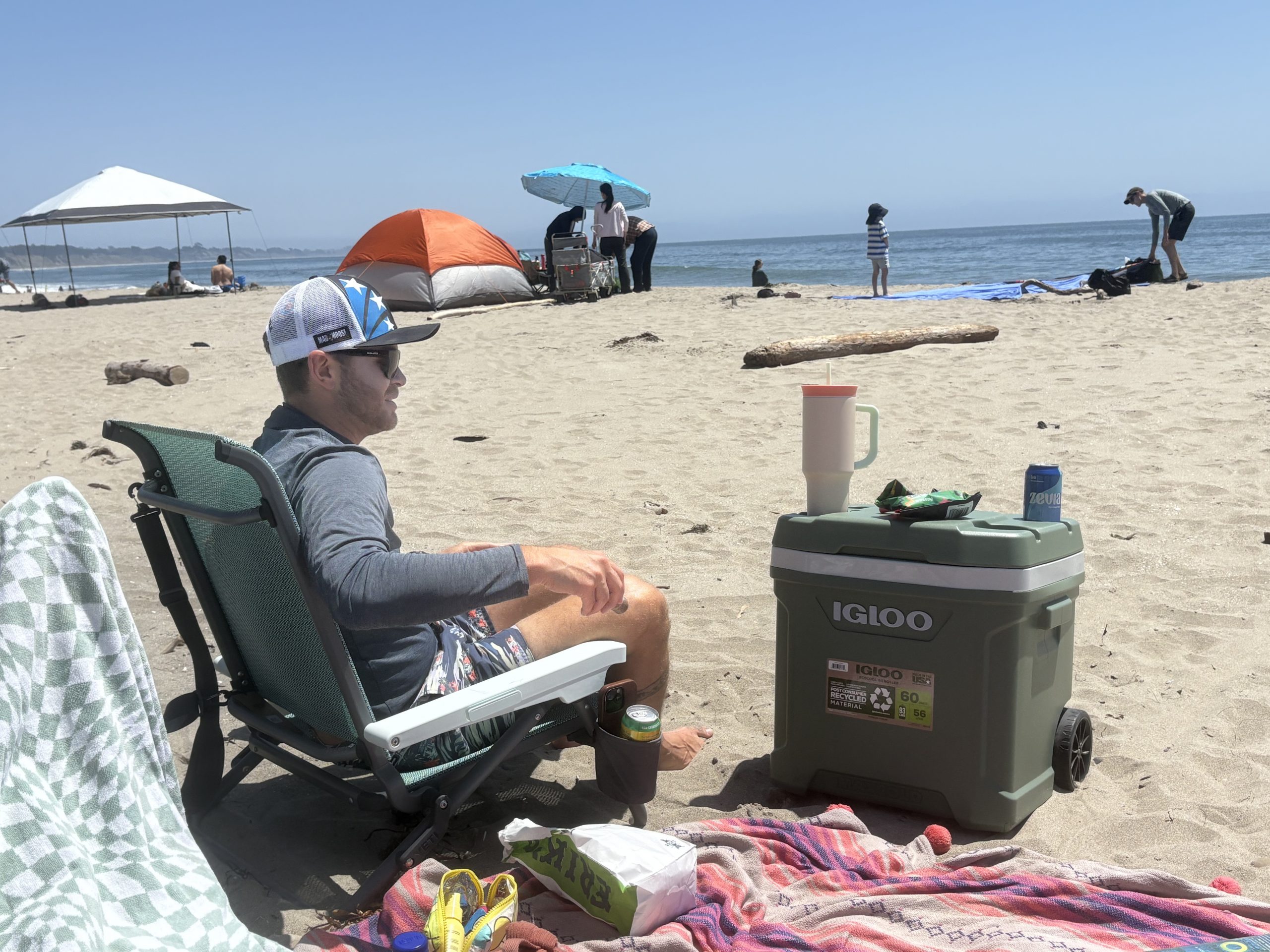
The Igloo ECOCOOL is a great option for the beach. The telescoping handle extends when you want it and collapses when you don’t. Photo: Rebecca Parsons//The Inertia
Use separate coolers for food and drinks
If you have the space and budget, it’s a great idea to have two coolers: one for keeping your perishables cold, and another for grabbing drinks often. This allows you to keep the food cooler sealed more frequently.
Keep your cooler out of the sun
Even if coolers boast incredible amounts of insulation, it’s a good idea to keep your beach cooler shaded. Leave it under your beach umbrella or shade structure if possible. If not, then try to put a towel or shirt on top just to make sure that it’s not getting direct sunlight. Not only will the contents stay colder longer, but it’ll also prolong the cooler’s lifespan.
Return to Comparison Table | Return to Top Picks
Related: Best Coolers | Best Backpack Coolers | Best Soft Coolers | More Gear



